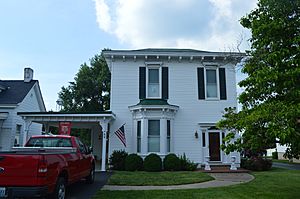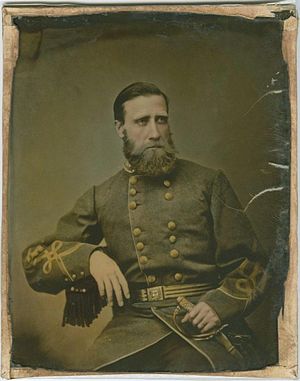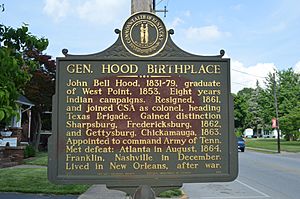John Bell Hood facts for kids
Quick facts for kids
John Bell Hood
|
|
|---|---|

Lt. Gen. John Bell Hood
|
|
| Nickname(s) | Sam |
| Born | June 1, 1831 or June 29, 1831 Owingsville, Kentucky |
| Died | August 30, 1879 (aged 48) New Orleans, Louisiana |
| Place of burial |
Metairie Cemetery, New Orleans, Louisiana
|
| Allegiance | United States of America Confederate States of America |
| Service/ |
United States Army Confederate States Army |
| Years of service | 1853–1861 (US) 1861–1865 (CSA) |
| Rank | |
| Commands held | 4th Texas Infantry Texas Brigade Hood's Division, First Corps, Army of Northern Virginia Second Corps, Army of Tennessee Army of Tennessee |
| Battles/wars | American Indian Wars American Civil War |
| Signature | |
John Bell Hood (born June 1 or June 29, 1831 – died August 30, 1879) was a brave and aggressive general who fought for the Confederate States during the American Civil War. He was known for his daring attacks and leadership on the battlefield. Many people considered him one of the best commanders of smaller groups of soldiers, like brigades and divisions, in the Confederate Army.
Contents
Early Life and Education
John Bell Hood was born in Owingsville, Kentucky. His father, John Wills Hood, was a doctor. His mother was Theodosia French Hood. John Bell Hood was also related to another Confederate general, G. W. Smith. His uncle, Richard French, was a U.S. Representative.
Starting His Military Journey
John Bell Hood's uncle helped him get into the United States Military Academy at West Point. This was a special school for training army officers. Hood graduated in 1853. He was almost kicked out in his last year because he had too many demerits, which are like penalty points. During his time at West Point and later in the Army, his friends called him "Sam."
Even though his school record was not perfect, Hood was offered a job as the main cavalry instructor at West Point in 1860. Cavalry are soldiers who fight on horseback. He turned down the job because he wanted to stay with his active army unit. He also wanted to keep his options open as a war seemed likely to start soon.
After West Point, Hood became a second lieutenant in the 4th U.S. Infantry. He served in California. Later, he moved to the 2nd U.S. Cavalry in Texas. There, he served under famous officers like Colonel Albert Sidney Johnston and Lieutenant Colonel Robert E. Lee. On July 20, 1857, while on patrol in Texas, Hood was wounded. An arrow went through his left hand during a fight with the Comanche people. This was the first of many injuries he would get during his military career. He was promoted to first lieutenant in August 1858.
A General in the Civil War
When the Civil War began, John Bell Hood joined the Confederate army, representing Texas. He quickly became known for his aggressive leadership. This happened when he commanded a brigade, which is a large group of soldiers, during the Seven Days Battles in 1862. After these battles, he was promoted to lead an even larger group, called a division.
Hood led a division under General James Longstreet in 1862 and 1863. At the Battle of Gettysburg, he was badly wounded. This injury made his left arm unusable for the rest of his life. Later, Hood and many of Longstreet's troops were moved to the Western Theater of the war. At the Battle of Chickamauga, Hood led a big attack into a gap in the Union army's line. He was wounded again during this battle, and his right leg had to be removed.
Even with his injuries, Hood returned to duty during the Atlanta Campaign in 1864. At just 33 years old, he was promoted to a temporary full general. This made him the youngest soldier on either side of the war to command an entire army, the Army of Tennessee. He led many bold attacks outside Atlanta. However, these attacks were not successful, and he had to leave the city.
Hood then led his army through Alabama and into Tennessee. His army suffered heavy losses in a large attack at the Battle of Franklin. He was then completely defeated at the Battle of Nashville by his former West Point instructor, Major General George H. Thomas. After this defeat, Hood was removed from his command.
Life After the War
After the Civil War ended, John Bell Hood moved to Louisiana. He became a cotton factor, which means he bought and sold cotton. He also became the president of an insurance company called the Life Association of America. In 1868, he married Anna Marie Hennen from New Orleans. They had 11 children in 10 years, including three sets of twins. Hood also helped his community by raising money for orphans, widows, and wounded soldiers.
During this time, he started writing a book about his experiences in the war. It was called Advance and Retreat: Personal Experiences in the United States and Confederate States Armies. The book was not finished or published until after he died. In it, he tried to explain his actions during the war. He also responded to what he felt were unfair statements made by other generals.
His insurance business failed because of a yellow fever outbreak in New Orleans in 1878–79. Yellow fever is a serious disease. Hood himself caught the disease and died on August 30, 1879. His wife, Anna, had died six days earlier from the same disease. Their oldest daughter, Lydia, also died on the same day as Hood. This left their 10 young children without parents or money. The Texas Brigade Association helped support them for over twenty years. Eventually, seven different families in various states adopted the children.
His Legacy Today
John Bell Hood is buried in the Hennen family tomb at Metairie Cemetery in New Orleans. A county in Texas, Hood County, is named after him. Also, a large U.S. Army base in central Texas was formerly named Fort Hood, but it is now called Fort Cavazos.
Images for kids
See also
 In Spanish: John Bell Hood para niños
In Spanish: John Bell Hood para niños






